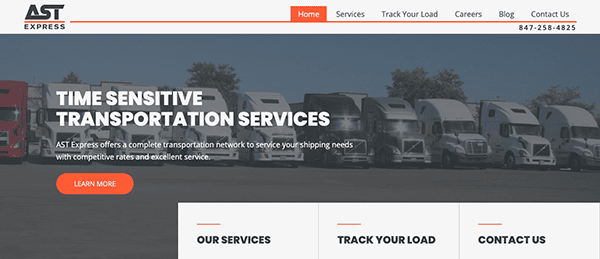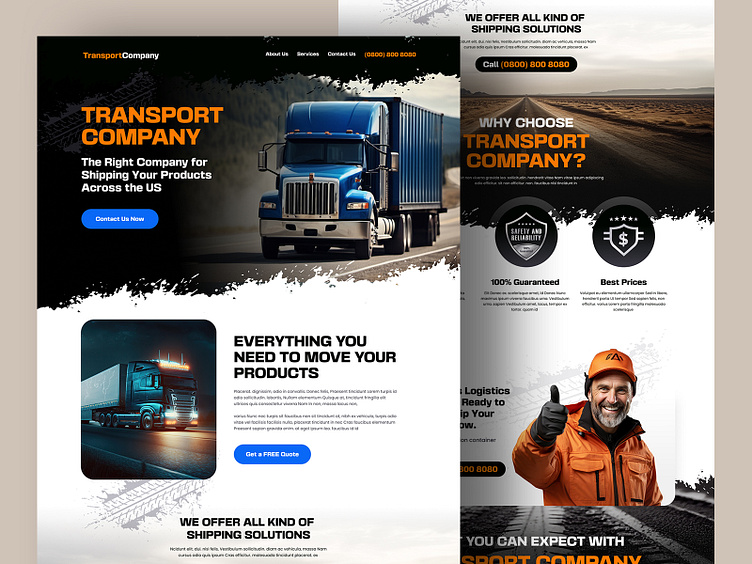Boost Your Brand With Tailored Transportation Web Style for Seamless User Experience
In today's competitive landscape, the relevance of a customized transport web layout can not be overstated. A well-crafted website not just functions as a digital store yet also plays a crucial role in shaping user experience and enhancing brand identification. By focusing on intuitive navigation and responsive designs, companies can ensure that possible clients involve with their solutions effortlessly, despite the tool utilized. The journey towards a reliable web visibility involves more than simply looks; it needs calculated selections that resonate with your target market. What aspects are essential in developing a genuinely impactful on the internet experience?
Importance of Custom-made Website Design
In the affordable landscape of transportation solutions, sticking out is important, and personalized website design plays a pivotal role in accomplishing this differentiation. A customized internet layout not only boosts a company's on the internet presence however also shows its unique brand identification, which is important in bring in and maintaining clients - transportation web design. This technique allows businesses to create a website that effectively interacts their services, worths, and objective, setting them besides competitors

Moreover, a well-designed web site can considerably boost online search engine presence, drawing in natural traffic and prospective consumers. Personalization additionally permits the assimilation of analytics devices, enabling firms to keep an eye on individual behavior and adjust their techniques accordingly. Inevitably, investing in tailored internet design is not just regarding aesthetics; it is a critical decision that enhances brand name recognition, individual engagement, and total business growth in the transport field.
Secret Elements of Customer Experience
Customer experience (UX) works as the cornerstone of reliable website design, directly influencing how site visitors interact with a transport firm's internet site. Several crucial elements add to an optimal UX, starting with instinctive navigating. A well-structured menu permits users to discover details promptly, minimizing disappointment and improving complete satisfaction.
An additional crucial element is packing rate; internet sites must do successfully to retain individuals' interest. A delay of just a few secs can cause higher bounce prices. Furthermore, visual power structure plays a crucial function, guiding customers through web content and making sure that the most essential information stands out.
Web content readability is essential, as it influences just how quickly users can absorb details. Clear typography, ideal font style sizes, and sufficient comparison improve clarity. Incorporating interesting visuals can enhance the user experience, making the website a lot more attractive and interesting.
Last but not least, availability can not be neglected. Designing for all customers, including those with handicaps, makes sure inclusivity and broadens the target market. By concentrating on these crucial elements of UX, transportation firms can develop a web site that not only attracts site visitors however likewise fosters engagement and commitment.

Benefits of Responsive Layouts
Regularly, companies ignore the relevance of receptive formats in website design, yet they are critical for accommodating the diverse series of gadgets users use today. A receptive format makes certain that your internet site adapts flawlessly to numerous display dimensions, supplying an ideal watching experience across mobile phones, tablets, and desktops (transportation web design). This flexibility boosts customer interaction, as site visitors are more probable to remain on a website that is very easy to browse, no matter the device they make use of
In addition, receptive layouts add to boosted search engine optimization (SEO) Internet search engine like Google prioritize mobile-friendly websites in their positions, which indicates that embracing a responsive format can cause boosted from this source visibility and greater traffic. Furthermore, maintaining a solitary receptive site reduces the demand for separate mobile versions, streamlining site monitoring and decreasing maintenance costs.
A professional, well-structured site that executes regularly throughout tools fosters depend on amongst individuals. Embracing receptive layouts is vital for any kind of business aiming to raise its on-line presence and individual contentment.
Enhancing Brand Name Identity
A strong brand identity is necessary for any transportation service wanting to attract attention in an affordable marketplace. It works as the foundation upon which Discover More client assumptions are built, influencing their count on and commitment. transportation web design. A well-designed internet site can substantially boost this identity, offering a graph of the brand name's worths, goal, and services
To effectively convey brand identity, transport internet design should incorporate consistent elements such as logo designs, color pattern, and typography. These components need to reverberate with the target market, producing a psychological connection that promotes recognition and recall. Additionally, the images made use of on the website must show the significance of the brand-- whether it's reliability, innovation, or speed.
By integrating these crucial layout elements and narration strategies, transport organizations can craft a cohesive and compelling on the internet visibility that not only records interest yet likewise builds enduring relationships with their clients. In doing so, they elevate their brand name identity, ensuring it remains remarkable in a crowded market.

Methods for Reliable Navigation
Reliable navigating is critical for any kind of transportation website, as it directly impacts customer experience and involvement. This permits customers to situate required info swiftly.
Integrating a search feature improves navigating even more, enabling customers to locate specific details effectively. Furthermore, breadcrumb navigating is advantageous as it supplies users with context about their current area within the website, making it less complicated to backtrack if required.
Using a receptive style is also crucial, guaranteeing that navigation continues to be straightforward throughout gadgets, from desktops to smartphones. Uniformity in navigating aspects, such as buttons and web links, promotes experience, which can result in improved customer retention.
Finally, think about implementing a sticky food selection that stays available as users scroll down the web page. This keeps important navigating choices within reach, boosting functionality. By concentrating on these strategies, transport websites can produce a smooth navigating experience that fosters user interaction and fulfillment.
Conclusion
